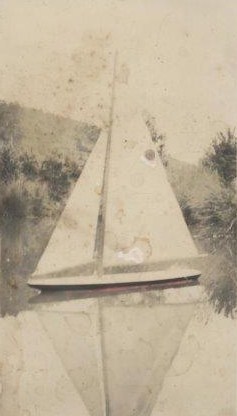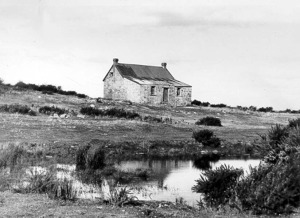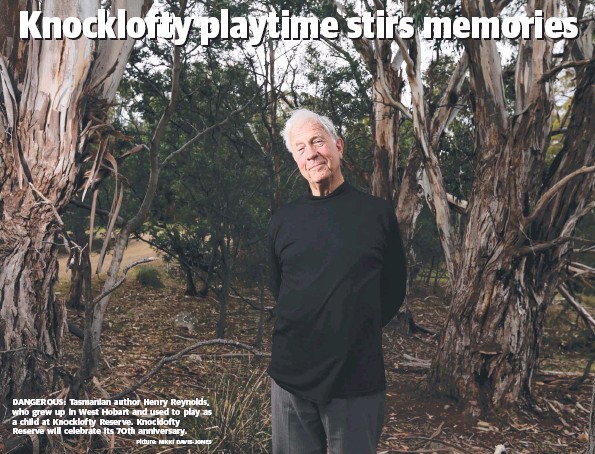11/8/2015 PressReader – Sunday Tasmanian – 8 Nov 2015 – Page #18 DAVID BENIUK
“It was in a sense a wild place, it was a place where big kids would chase you.” HENRY REYNOLDS
KNOCKLOFTY Reserve could be a dangerous place back in the day. Shooters, cliffs, fires and even angry squatters are forged in the memories of those who as kids roamed the bushland, long considered Hobart’s backyard. The reserve will celebrate its 70th anniversary next weekend and those memories are being collected as part of an interpretation project. Renowned historian Henry Reynolds grew up in Knocklofty Terrace, spending much of his childhood in the 1940s on the reserve. “Kids just went off after breakfast and were away all day,” the 77-year-old tells the Sunday Tasmanian. “We’d just go up and wander across the hills, even when we were quite young. “It was in a sense a wild place, it was a place where big kids would chase you and shoot their air rifles at you — you had to be pretty careful.”
Kids were sent off with a chop to cook on an open fire, for a game of cricket or to collect tadpoles from the reserve’s ponds. Professor Reynolds’s sister, Judy Scott, remembers playing in quarries and caves. “It was pretty dangerous but we used to go along the cliff and go into the caves and play cops and robbers and bushrangers,” she said. Much of the fun centred on an old farm dwelling known as the Pigeon House, which 79-year-old John Lahey remembers as a squat for itinerant fruit-pickers. “This kid came out shaking his fist at me,” Mr Lahey recalls. Hobartians welcomed a decision by the council to purchase the 175-acre site in 1943, seeking to save it from timber cutting for firewood. Axes, firearms and fires were banned as it became a reserve in 1945 and a suggestion it be named Churchill Park knocked back.
Professor Reynolds says it is likely to have been an open, grassed Aboriginal hunting ground before proving attractive to farmers. Tree-planting in recent decades has failed to take that history into account, he argued. “Their idea was to take it back to what it was once upon a time but I don’t think it was ever like that you can’t hunt if you have lots of trees,” he said. “I would like to see that whole area opened up again for recreation as it historically had been.”

Bill Stennard’s dad’s yacht tryout in the Knocklofty frog pond in 1942
Old Pigeon House
 http://catalogue.statelibrary.tas.gov.au/item/?q=West+Hobart&i=112&id=PH30-1-5135
http://catalogue.statelibrary.tas.gov.au/item/?q=West+Hobart&i=112&id=PH30-1-5135
Anybody know anything about this?
Up on the Knocklofty Reserve near the frog pond(?) in the foreground. Was it destroyed by the ’67 bushfires?
Who owned/built/lived in it?
“The Pigeon House near the frog ponds was already gone by the early 50s when we used to roam the hills and fish for tadpoles. Definitely gone before the ‘67 fire. I recall that there were some stones which look like those in the photo of the building lying around near the ponds.”
Regards
John Berry
UNDERSTANDING THE CONTEMPORARY CULTURAL VALUES OF KNOCKLOFTY RESERVE
A report to the City of Hobart by Dr Caroline Evans and Dr Kathryn Evans December 2015
Click to access Knocklofty_Contemporary_Cultural_Values_Final_Report.pdf
Knocklofty_Contemporary_Cultural_Values_Final_Report
Knocklofty’s industrial history almost lost but not forgotten
Suzanne Smythe and the history of Knocklofty Reserve.
One of the most popular recreational reserves in Southern Tasmania is an area over-looking Hobart, known as Knocklofty.
Meaning High Hill, Knocklofty is a location where people from all over the city come to walk their dogs, practise tai-chi and ride their bikes.
Although Knocklofty is now an expansive, forested reserve owned by the Hobart City Council there was a time when it’s hills were bare and the most prominent plant was gorse.
Suzanne Smythe is an author and local historian whose interest in Knocklofty was piqued after a discovery she made one morning while walking its tracks with her dogs and granddaughter.
Paul McIntyre spoke with Suzanne Smythe to find out more…
Duration: 16min 4sec


I believe the Ward family documented that only the stone step remained in 1994 and they took photos at that time. We and the Wards descend from the convict George Allcorn (Alcorn), who lived in the Pigeon House in 1841-43. The land was owned by Dr Ross (and later by his widow Susanah). Here is what we know:
George Allcorn was from the Uckfield area of Sussex in England. George was a ploughman (agricultural labourer) and had 3 young children with his wife Frances Hilder. George Allcorn arrived in Tasmania as a convict in 1832, having been sentenced to transportation for 7 years for receiving stolen goods (leather) on 10th December 1831. George Allcorn’s convict records are: http://portal.archives.tas.gov.au/menu.aspx?detail=1&type=C&id=592
George Allcorn was assigned to Mr RC Gunn from the Launceston District in 1833 and to Mr Peevor from the Richmond District in 1835 (most likely Mr J Peevor). George’s ticket of leave was not recorded until 1841. By this time, George was reunited with Frances and his children. Frances (aka Fanny) arrived in Hobart aboard the barque “Janet” on 2nd December 1834 with their 3 children (Maria, Edward and George). George and Frances went on the have 3 more children in Australia: Louisa in 1836 (who died of influenza in 1839), Frances Honor/Hannah in 1839 and Ann Jane in 1840. In 1841 & 1843, the census shows George and family living west of Hobart as tenants in a stone cottage called ‘the Pigeon House on Nocklofty’, owned by S Ross (Susannah, nee Smith, widow of James Ross, aka Dr James Ross). George was working as a gardener for Susannah Ross and is believed to have grown grapes at this time.
James Ross was a schoolmaster who was the tutor to Governor Arthur’s children in 1825. He became a prominent and influential publisher, editor of The Hobart Town Gazette (1825-1827) and took charge of the government printing office. He went on to publish the weekly Hobart Town Courier (1827), the annual Hobart Town Almanack (1829-1836), the Hobart Town Chronicle (1833), and the Van Diemen’s Land Monthly Magazine (1835). Some of his articles in the Hobart Town Almanack were used by Marcus Clarke in For the Term of His Natural Life. In 1832, he was granted 312 acres (126 ha), Paraclete, on Knocklofty, making him one of the earliest settlers in the Mount Stuart area. He built a homestead in the vicinity of Summerhill Road (now West Hobart) and a substantial stone pigeon house on Knocklofty. It is believed he had ambitions to lay out botanical gardens but it never came to fruition. Parclete is thought to have covered 430 acres comprising Knocklofty and the top of today’s Mount Stuart, extending from the Female prison to Kangaroo Bottom (now Lenah Valley). Dr Ross retired in 1836 and in his last address to the public, he said, “independence of spirit has been my motto; freedom my watchword; the happiness of my fellow-men my object; and the truth of our religion my buckler and consolation”. He acquired Carrington in Colebrook Road, Richmond from Governor George Arthur. James Ross died of apoplexy on 01/08/1838 and was buried in St Luke’s cemetery, Richmond, leaving his widow with thirteen children. Susannah moved her boarding school from Carringtonto Paraclete in 1842, subsequently married Robert Stewart, a solicitor, of Hobart, and died at Battery Point on 12 May 1871, aged 75:
http://adb.anu.edu.au/biography/ross-james-2607
http://www.daao.org.au/bio/james-ross/biography/?
http://gutenberg.net.au/ebooks/n00012.html
http://www.mountstuarttas.org.au/?q=content/people
“Pigeon Houses” were so-called because of their 2nd story, high-pitched roof line and possibly some people kept pigeons in the roof. The Pigeon House was demolished many years ago, but Bryce Ward managed to locate the foundations and the well-worn doorstep in 1994. It was set high on the hill, commanding great views but in a very windy location, surrounded by open paddocks, quite some distance from the town. George’s later children told stories about walking down to Hobart for school and having to hide from roaming bushrangers! Early settlers grazed cattle here, cut firewood and quarried the sandstone for many of Hobart’s first buildings. Knocklofty is above Cascade Rd / Upper Macquarie Street where they subsequently lived. The entire area was known as Queensborough, Hobart Town back then. Knocklofty hill was also known as Mount Stuart or Paraclete: http://en.wikipedia.org/wiki/Mount_Stuart,_Tasmania
The pigoen house photo can be found on state archives here: http://catalogue.statelibrary.tas.gov.au/item/?id=PH30-1-5135
On 28/06/1848, George Allcorn acquired 2 pieces of land, 1 in Macquarie Street and 1 in Washington Street in the Electoral District of Queensborough, now known as South Hobart. George died there in 1867, aged 74. Frances died peacefully and in full possession of her faculties, aged 86, on July 11th 1884, at the home of her son-in-law Thomas Fletcher Jones. Note: Frances was buried as Frances “Alchorne”.
ps. Taswegians – we have done our best from afar as we do not live in Hobart. The names of the Knocklofty area and suburbs (old & new) were gleaned from various wikipedia and references in other documents online. If anything needs amendment please let me know – thanks!
Hi Maree, I can confirm the same family story. Please send me your email. 3rd great grand-daughter to William Ward and George Allcorn/Alcorn/Alchorne.
In the 1858 land record, the Pigeon House in Knocklofty was registered to a Douglas Kilburn with a 3 pound annual assessed value.
Hi Maree and Suzanne,
I too am descended from the convict George Allcorn (Alcorn). He was my 2nd great grandfather and Floriline Alice Allcorn was my grandmother. Would love to make contact with you both.
Ah, yes, I see Floriline there on the family tree. We know about her sister Daphne being run down by Squizzy Taylor in 1924 (terrible!). I gather her father, Thomas, was a good cricketer.
The Ward family wrote their own book which contains some Alcorn/Allcorn history (we have a few corrections to it on file) and we have done some research ourselves, some of which I posted above.
George had a half brother named Jonathan Harris convict . He was assigned to George in 1850 . I am descended from Jonathan
Hi Maree, Barry Wheals here, as you know I am also a descendant of George Alcorn, 3 x great grandfather I think lol, great to see other rellys having a say on this site.